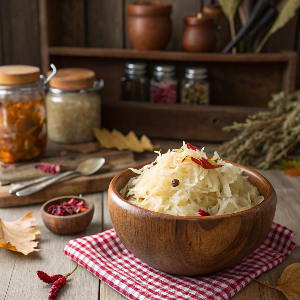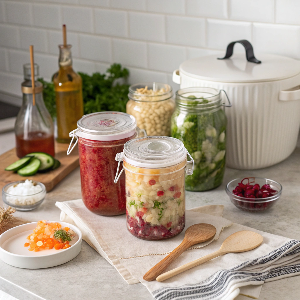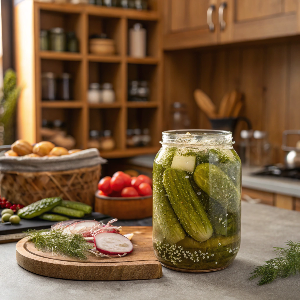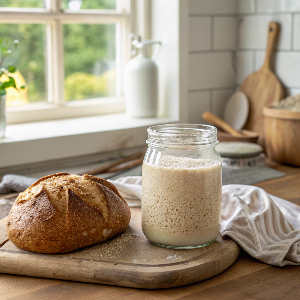A Beginner’s Guide to Gut-Healthy Goodness

Fermenting food might sound complicated, but it’s actually a simple, ancient method of preserving food and boosting its nutrition. People all over the world have been fermenting for thousands of years, and now more and more people are doing it at home. Whether you’re curious about sour pickles, fizzy tea, or homemade yogurt, fermentation is a doorway to deeper flavor and better health.
This guide introduces the major types of fermented foods—what they are, why they matter, and how they connect to global food traditions. It’s not a how-to manual, but a starting point for anyone who wants to understand what makes fermented foods so powerful.
Safety First
Before diving in, it’s important to acknowledge that fermentation relies on live bacteria—and while most are good, not all are. Proper technique is essential to prevent unwanted microbes from taking over.

- Use clean jars and tools
- Start with fresh ingredients
- Keep items submerged and oxygen-limited
- Store at the right temperature
Disclaimer: This article is for educational purposes only. Always follow tested, trusted recipes and refer to reliable sources for specific instructions.
See our food safety tips for fermentation
What Is Fermentation?
Fermentation is a natural process where microbes like bacteria and yeast break down sugars in food. In doing so, they create acids or alcohols that preserve the food and change its flavor, texture, and nutritional content.
There are two types most relevant to home kitchens:

- Lactic acid fermentation: Used in making pickles, yogurt, kimchi, and sauerkraut. It produces lactic acid, which gives fermented foods their tangy flavor.
- Alcohol fermentation: Common in drinks like kombucha and traditional sodas. Yeasts convert sugar into alcohol and carbon dioxide, resulting in natural fizziness.
For thousands of years, people around the world have relied on fermentation to store food, enhance nutrition, and even prevent illness.
Meet the Microbes
Behind every successful ferment are beneficial microbes. These microscopic helpers not only preserve food—they transform it.
- Lactobacillus: A friendly bacterium found in many vegetable and dairy ferments. It creates lactic acid, which helps prevent spoilage and supports gut health.
- Bifidobacterium: Found mainly in dairy ferments. It plays a role in digestion and nutrient absorption.
- Saccharomyces: A yeast used in kombucha, sourdough, and beer. It adds bubbles, flavor, and complexity.
Together, these microbes produce enzymes, vitamins, and other compounds that benefit the gut—and in turn, your overall well-being.
What the gut microbiome really does
How Fermented Foods Support Health
Fermented foods offer more than flavor. Research suggests they can:
- Help restore balance in the gut microbiome
- Improve digestion and make nutrients more available
- Support immune function
- Reduce inflammation
- Possibly improve mood and mental clarity through the gut-brain axis
Some people notice fewer digestive issues, more energy, or clearer skin after adding fermented foods to their daily routines. While results vary, the link between gut health and overall health is becoming harder to ignore.
Fermenting Vegetables
Fermenting vegetables is one of the most approachable and traditional ways to begin exploring fermentation. Nearly every culture has its own signature vegetable ferment, and each brings unique flavors and textures to the table.
Pickles

Real fermented pickles have deep roots in Eastern European and Jewish deli traditions. The classic kosher dill you might find at a New York deli isn’t just sour—it’s tangy, garlicky, and full of live cultures. These pickles are made without vinegar, relying instead on salt and time to develop their flavor. Unlike shelf-stable vinegar pickles, fermented pickles are usually found in the refrigerated section or made at home in small batches.
Sauerkraut
Sauerkraut is finely shredded cabbage that ferments in its own juices. It’s a German staple, often served alongside sausages or roast pork, but it’s also found in other forms across Central and Eastern Europe. When naturally fermented, sauerkraut has a crisp texture and a balanced tang, far removed from the overly sour canned versions. It’s rich in beneficial bacteria and adds crunch and acidity to all kinds of meals.
Kimchi
Kimchi is the heart of Korean cuisine. It’s a bold, spicy, and complex ferment traditionally made with Napa cabbage, radish, garlic, ginger, and chili pepper. There are hundreds of varieties—from mild white kimchi to fiery red versions that pair beautifully with rice, noodles, or grilled meats. In Korea, kimchi is served with nearly every meal and is considered essential for both flavor and health.
Other Popular Vegetable Ferments
- Carrots – Slightly sweet and easy to ferment. Often paired with ginger, garlic, or dill.
- Beets – Earthy and vibrant in color. Common in Eastern European ferments and in drinks like beet kvass.
- Green beans, cauliflower, and turnips – Often used in mixed vegetable ferments across the Mediterranean and Middle East.
Fermented vegetables are more than just tangy snacks—they’re part of culinary traditions passed down through generations. They’re used to preserve seasonal harvests, add acidity to rich dishes, and promote digestion.
Fermented Drinks
Fermented drinks offer a refreshing, slightly effervescent way to enjoy probiotics. They’ve been around for centuries in many parts of the world, often associated with social rituals, home remedies, or seasonal celebrations.

Kombucha
Originating in East Asia, kombucha is a fermented tea known for its tangy flavor and natural carbonation. It’s made using a culture called a SCOBY (Symbiotic Culture of Bacteria and Yeast). Traditional kombucha is slightly sweet, slightly sour, and full of living microbes. While it has gained popularity in the wellness community, its roots are much older—often brewed in small ceramic crocks as part of family traditions.
Water Kefir
Lighter and gentler than kombucha, water kefir is a probiotic beverage with Central American and Eastern European origins. It’s often described as a “natural soda” because of its subtle fizz and mild sweetness. Some cultures ferment it with dried fruit or citrus peels, making it both nourishing and festive.
Milk Kefir
Thicker and creamier than water kefir, milk kefir is a tangy dairy drink with origins in the Caucasus Mountains. It’s similar to drinkable yogurt but with a more diverse population of beneficial bacteria and yeasts. Historically, it was passed down through generations using grains that were never sold—only shared—making it one of the more community-driven ferments in the world.
Tepache and Ginger Bug
Tepache is a lightly fermented Mexican drink traditionally made with pineapple peels, cinnamon, and raw sugar. It’s mildly fizzy, slightly funky, and served chilled on warm days. Ginger bug, on the other hand, is a homemade starter made from ginger, sugar, and wild yeasts—it’s often used to ferment homemade sodas and herbal drinks.
Fermenting Fruits
Fermenting fruit can feel a little unexpected at first, but it’s a practice rooted in both tradition and necessity. Before refrigeration, fermentation was one of the best ways to preserve fruits, especially during harvest season.
Fermented fruit tends to develop light carbonation and a gentle sourness that plays well with natural sweetness. The result is something you don’t usually find on grocery store shelves: a fruit that’s alive, evolving, and unexpectedly complex.
- Pineapple is often used in Central America and Mexico for tepache, but it’s also delicious as a tangy topping on yogurt or ice cream.
- Berries—like strawberries, blueberries, and raspberries—ferment quickly and are used in Eastern European and Nordic traditions as spoonable preserves or drink mixers.
- Mangoes and peaches become deeply aromatic and pair well with spicy or savory dishes once fermented.
Fermented fruit opens up new flavor territory and makes the most of produce that might otherwise spoil. It’s also a natural fit for anyone looking to reduce food waste and explore traditional preservation methods.
Dairy Ferments
Fermenting dairy has been practiced for millennia, especially in regions where refrigeration wasn’t available. The result? Some of the most beloved comfort foods and health-promoting staples in the world.
Yogurt
Found in countless cultures—from Greek to Turkish to Indian—yogurt is one of the oldest known fermented foods. Its creamy texture and tart flavor are the result of bacterial cultures transforming milk sugars. In many countries, yogurt is consumed daily, whether as breakfast, a drink, or a cooling side to spicy meals.
Milk Kefir
If yogurt is the gateway, milk kefir is the deep dive. Originating in the mountainous regions of Eastern Europe and Western Asia, kefir has a thinner consistency and a much broader array of probiotic strains. It’s slightly fizzy, mildly sour, and full of character.
Cultured Butters and Cheeses
In many traditional food cultures, butter wasn’t just churned—it was fermented. Cultured butter, with its slight tang and deeper richness, is still prized in parts of Europe. Soft cheeses like labneh, quark, and paneer can also involve fermentation. These foods bridge the gap between flavor, nutrition, and tradition.
Other Fermented Staples
Not all fermentation happens in jars of vegetables or bottles of fizzy drinks. Some of the most quietly powerful ferments live in bread, sauces, and spreads.
Sourdough Starter

Sourdough is bread’s answer to fermentation. Instead of commercial yeast, sourdough uses wild yeasts and bacteria from the environment to leaven the dough. The result is a loaf that’s easier to digest, more flavorful, and full of character.
Many cultures have their own version of sourdough. In San Francisco, the local strains of bacteria give the city’s famous sourdough its distinctive tang. In Europe and the Middle East, traditional rye and wheat sourdoughs are still common in home kitchens and village bakeries.
Sourdough isn’t just about bread—it’s a living culture that reflects your home, your climate, and even your routine.
Fermented Condiments
Condiments are where fermentation often hides in plain sight:
- Hot sauce – In many Latin American and Caribbean traditions, chili peppers are fermented with garlic and salt to create deeply flavorful sauces.
- Mustard – Early mustards were naturally fermented, giving them a sharper, more layered taste.
- Ketchup – Before it became a sugary tomato product, ketchup was a fermented fish sauce in Asia. Fermented versions today recapture some of that original depth and umami.
These small additions to meals offer big boosts in flavor and digestion—and a taste of history with every bite.
Final Thoughts
Fermenting foods at home isn’t just a hobby. It’s a chance to connect with traditional food cultures, take control of your gut health, and discover new flavors you won’t find in mass-produced products.
Start with curiosity, not perfection. You don’t need to know everything—just enough to take that first step.
[Visit our fermentation recipe hub to explore more]
Happy fermenting
